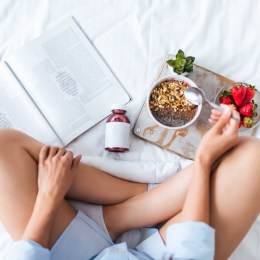India’s natural beauty and wellness secrets date back over 5,000 years – and they can teach us many things today, says Yasmin Sadikot*.
The Indians understood the quality of the elements (space, air, water, earth and fire), the relationship of these elements in every living thing and the way they interact in our daily lives.
Seasons, age, moon cycles, environment, lifestyle, food and relationships all have an effect on our mind, body and spirit; the way we look, the way we move, see, think and live. Indian natural beauty encompasses these deep understandings.
In ancient India, beauty rituals were performed in intimate and luxurious spas within the royal palace walls. They were very private. Men’s and women’s spas were built well away from each other.
An Indian woman is the Lakshmi, or the Goddess of wealth and prosperity. She therefore exhibits the wealth and social status of her family. Most Indian women are adorned with exotic jewellery, clothes and are handed down the beauty rituals, originally only within the palace, from mother to daughter.
Ancient recipes, part of Indian herbal heritage, have not only stood the test of time, but have been most beneficial in counter-acting the harmful effects of synthetics and chemical preparations.
In Indian tradition, a combination of culinary, medicinal and aromatic herbs, flowers, barks, seeds, wood, roots and naturally occurring minerals are combined together to make pastes that cleanse, detox, exfoliate and nourish the skin giving it radiance and good health.
The beauty ritual encompasses the whole woman; her face, body and scalp. Once only performed in the palaces (sometimes extending to 40 days) for the queens, now for Indian women the beauty ritual is part of everyday life (particularly on special occasions), and performed by a therapist in the home or in a spa or salon environment.
A typical ritual consists of a pre-wash detoxification, a bath, a marma point massage incorporating a facial, a body mask and deep exfoliation, another bath, a hair and scalp treatment and body and facial hair removal (hair removal is almost mandatory, as a clean skin is a perception of beauty).
Bathing Ritual
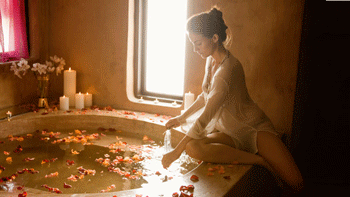
Bathing is a ritual whether for religious ceremony, special occasion or personal renewal. In India great importance has always been attached to the bath, a ritual of physical and spiritual cleansing.
The water is believed to connect the bather with the universe and, as one descends into the realms of water, all care are left behind. Ritual baths took place as a symbol of purification, removing all evil.
Pre-wash Detoxification
Using turmeric in creams is an ancient germicidal and skin-softening remedy. Organic turmeric combined with lemon is rubbed over the body to thoroughly cleanse, detoxify and decongest and washed off in a scented bath.
This combination is still a traditional part of the Indian wedding ritual to beautify the bride for the ceremony.
Marma Massage
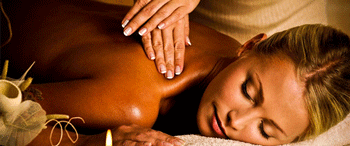
Body massage, using warmed herbal oils, is part of Indian life. Marmas are the primary seat of vayu or vital energy. A marma point massage is relaxing and also alleviates and helps prevent many health problems.
By making gentle circular motions on a marma point, toxins can be released. The pada (feet) and hasta (hands) are very important. Specific foot and hand massage focusing on the marma point is known as padabhyanga and hastabhyanga.
There are 107 marma points on the body, seven of which are the main chakras points, 22 are on the lower extremities, 11 on each arm, 12 in the chest and abdomen, 14 on the back and 37 in the neck and head areas.
Ayurvedic Facial
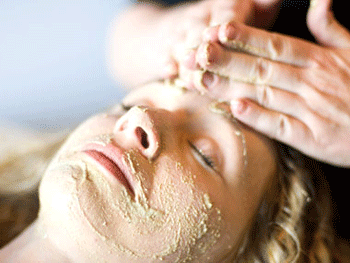
An Ayurvedic facial begins with a warm herbal scalp massage starting at the brahmand (anatomically the space between the two cerebral hemispheres) or located eight finger widths above the third eye, and then working along the marma points located on the head and neck.
Application of nourishing herbal oils to this area calms and strengthens the brain and nervous system. As part of a facial treatment it helps to increase the fresh supply of oxygen and glucose to the brain, relaxes the nervous system, improves circulation and increases the brain’s pranic energy.
The next phase is to deep cleanse the face and neck with herbal cleansers to suit the person’s dosha. The deep cleansing follows a general cleansing to remove dirt and grime.
The deep cleanse treatment uses a fresh preparation of herbs and grains (ubtan) made into a paste using milk, eggs, yoghurt, honey or water. The ubtan is left on for 15 minutes and then gently exfoliated off in circular motions.
This treatment is excellent for all skins, but especially so for acne, pigmentation and deep seated skin problems.
A marma point face and neck massage using nourishing herbal creams is followed by steam compress (cold compress for pitta types) preparing the skin for the balancing herbal mask.
The mask is left on for 25 minutes to detox, rejuvenate, heal, balance and tighten. During the mask the practitioner performs the hastabhyangha and padabhyanga using nourishing and rejuvenating herbal creams.
With 37 marma points alone on the neck and head, it is no surprise that an Ayurvedic facial is deeply relaxing. On completion of the facial the recipient is left to rest and ‘just be’ in relaxed surroundings filled with fragrances from fresh flowers.
Ubtan – The Body Mask
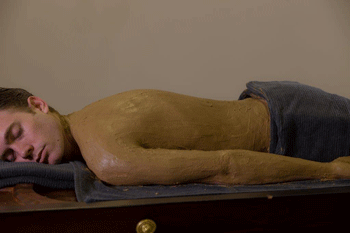
The massage is followed by a herbal ubtan (body mask), a fragrant mix of ingredients selected to suit the individual. These ingredients include such herbal powders as white and red sandalwood, rose, organic turmeric root, dried orange peel, camphor, neem, madder and ashwagandha, along with starch and husk.
The ubtan preserves the skin’s suppleness and youthful quality by retaining the body’s natural oils and where necessary augmenting them.
Some herbs purify the blood; others nourish the tissues or have softening or firming benefits. The ubtan is moistened with milk, eggs, honey or egg, according to the individual’s dosha making a paste for application. Skin is tightened by starch. The herbs provide nourishment and purification (detoxification) and the husk exfoliates. When dry, the mask is moistened with milk or yoghurt again, and exfoliated off using the hands in circular motions, rather like dry body brushing.
The ritual then continues with a second bath with scented oils and/or fresh aromatic herbs and flowers infused in the water. The can include sandalwood powder, rose, jasmine, vetiver (khas) or milk. The scent of fresh flowers is mandatory as the breathing becomes deeper, expelling accumulated stress and lifting the spirits by increasing serotonin to impart a feeling of happiness and inner wellbeing.
Hair Removal
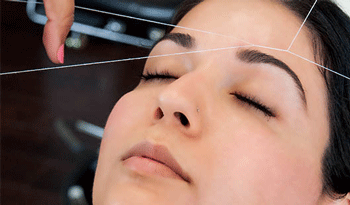
The traditional hair removal recipe uses organic lemon and sugar – hygienic and good for the skin.
Threading is a popular form of hair removal in India to remove fine hair such as facial hair and eyebrows. All that is required is 100 percent cotton thread and talcum powder. The talc is sprinkled on the area to be threaded to provide a silky surface to allow the thread to grip (the hair) easily. An ‘experienced threader’ works quickly and can access the finest hair to give eyebrows perfect shape. Threading is non-intrusive with no heat, pulls hair from the roots and over time, reduces hair growth.
One end of the cotton thread (sewing thread) is held between the teeth, while the middle of the thread is made into a loop with one hand. The other hand manoeuvres the thread. The mouth and the hand work together to catch the hair in the loop, plucking it out with the movement of the thread.
Ayurvedic Hair Treatments
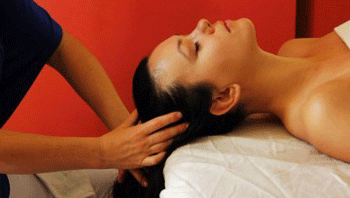
A healthy scalp grows healthy hair. The traditional Ayurvedic treatment is to massage the scalp with warm herbal oil applying firm pressure. This conditions the scalp and calms the mind.
Herbal sesame hair oil infused with fenugreek, brahmi and amla is very nourishing, promotes hair growth, slows the greying process and gives the hair shine. There are numerous therapeutic benefits of using a herbal oil, the main being that it helps to strengthen and remove and or prevent dryness, which is responsible for brittle hair, premature balding and many scalp disorders.
At home, the oil is left on overnight. In a spa, the hair is wrapped in a steamed hot towel to open the scalp pores, encouraging the oil and herbs to penetrate into the follicles. Hair is washed in reetha, known as soap nut, and mixed with amla, henna, brahmi and shikakai again to nourish hair follicles.
Hair is then dried over incense so that the fragrance stays in the hair for a number of days. It is no wonder Indian women have such luxurious long, thick hair as they are given this treatment from childhood.
Attar
Lastly, the perfuming of the body. The Moghuls introduced attars, a strong, concentrated perfume distilled from flowers, bark, leaves and wood. These intoxicating scents are packaged in tiny crystal jars and complete the beauty routine.
This ancient style of treatment, so relevant for today’s client provides detoxification, nourishment, rejuvenation and a new sense of wellbeing and confidence, a clear mind and a renewed lease of life.
- Yasmin Sadikot is the Founder of OmVeda International Pty Ltd and a pioneer in traditional Ayurvedic beauty treatments and home care products in Australia. A qualified homeopath, Yasmin has studied Ayurvedic herbology and treatments over the last 25 years, working with world-leading Ayurvedic cosmeticians and doctors. OMVEDA.COM.AU


